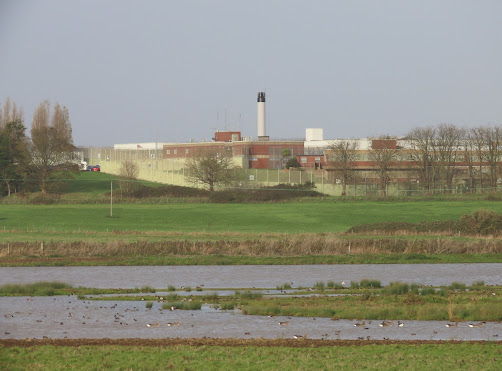Hollesley is not perhaps the most famous of RSPB reserves, but among local birdwatchers its gaining a reputation of attracting some unusual birds, especially in winter. The reserve contains areas of flooded grassland, with drier areas on the higher grounds towards the back, but the centrepiece of the reserve is the scrape. This habitat is an area of water literally scraped out of the soil, lying beneath the shadow of the prison behind. This habitat consists of very shallow water with islands, set amongst grassland. This habitat attracts large numbers of birds to nest, as well as winter, in Hollesley's case, good numbers of waders. At this time of year the birder's mind wanders to thoughts of wintering geese arriving on our shores, but unfortunately so far with the mild weather, very few of those birds have turned up on the Suffolk Coast.
On approaching the scrape, things didn't look too promising, as the only birds present seemed to be a large flock of GULLS roosting on an island. In among this group there were many types of species, of various ages and plumages but with a bit of diligence I was able to spot three adult CASPIAN GULLS among the throng. Identifying gulls can be daunting at the best of times, and can be quite a headache for even a seasoned birder like myself. Caspian gulls are basically the type of herring gull to be found in the Black Sea area. At this time of year they can be easily be told apart from the similar herring gulls by a clear unmarked head (the herring gulls have a grey streaking to their head), in essence looking like large kittiwakes.
With a closer look more birdlife was revealed on the scrape, with lots of ducks tucked round the edges of the water. Wildfowl numbers were still fairly low, the mild conditions don't really benefit the large numbers you usually get with hard winters. As is usual for this type of habitat the largest number of ducks were of TEAL and WIGEON, with a decent number of PINTAIL also showing up. The small flocks of SHOVELLER were graced by a leucisitic bird, an almost all white duck, which has been hanging around for a while, and small numbers of GADWALL were also about.
Three MARSH HARRIERS were around, hunting the surrounding grasslands, all of them females. These graceful raptors are always majestic to see, and no matter how common they have become in this part of the country, I never tire of watching them. A pair of STONECHATS were in a bramble bush along the path to the river wall, as usual perched right on the very top, always posing themselves. On the estuarial river Ore the tide was up, and only a SEAL was about, with a few REDSHANK flying up and down river. This is close to where the river Ore meets the sea, and large numbers of CORMARANTS rest on the shingle banks of Orford Ness, drying their wings after successful fishing, in preparation of going back into the water.
This was a bit of a rush job today, I didn't really having the time to spend longer, or to visit anywhere else. That's the beauty of Hollesley, its small size means it can be done in a hour, and is also in close proximity to other reserves along the coast like Boyton, which you can visit briefly as well. To be honest I was only looking for the caspian gulls to add to my yearlist, as they are easier to identify at this time of year. Around the turn of the year our herring gulls lose the grey streaking and resemble caspians, meaning I will have to get into anal plumage details to tell them apart. Such is the fun of birdwatching.





No comments:
Post a Comment